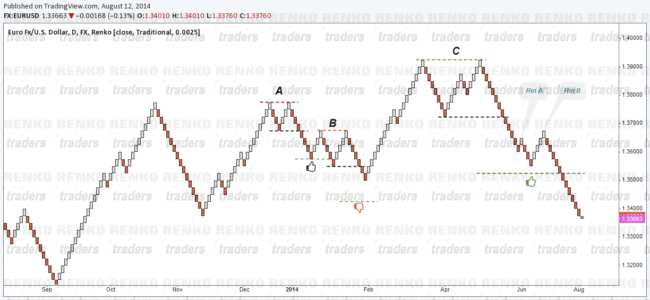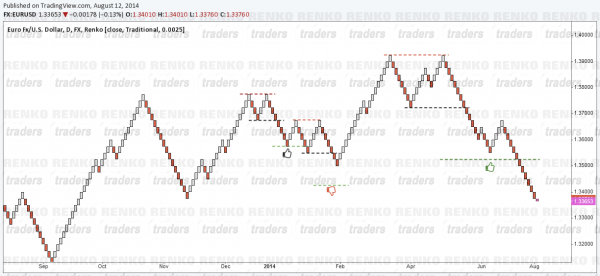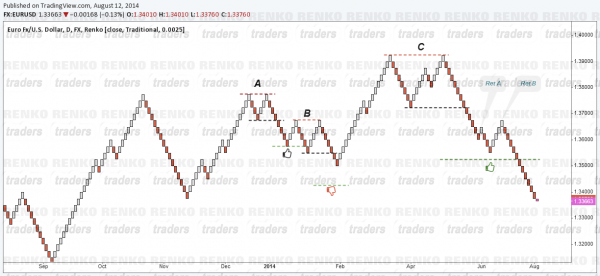Trading chart patterns is easy. With Renko charts, it is a lot easier to trade the chart patterns due to the apparent way the Renko charts are built. However price action traders would know that not all chart patterns are created equally. Some work like a charm, some fail miserably. This makes anyone wonder, what is it that one thing which would qualify and separate the good chart patterns from the bad.
Due to the vastness of this topic, in this article, I’ll focus only on double tops and double bottom Renko chart patterns. In later articles, I’ll cover other chart patterns as well.
So let’s get on to find out how to trade Renko chart patterns, the double tops and double bottoms (as well as triple tops and triple bottoms) effectively and how to identify good Renko chart patterns from the bad ones.
In the Renko chart below of EURUSD, I plotted some random DT’s. You can see how the first DT worked greatly, reaching its target. The second DT failed, while the third, a much larger Renko double top took some time but managed to reach its target eventually.
Is there something common to the successful Renko double top chart pattern?
How to find the best Renko double tops and double bottom chart patterns
Let’s look at the chart again closely, this time focusing on the first Double Top Renko chart pattern.
What we see here are two possible ways to trade.
- The first approach is to blindly set a sell order at the reversal between the two tops. The target would be the same distance from this reversal to the double top.
- The second approach to trading Renko chart patterns is to wait for a retracement and then trade.
Pay attention to “A” Double top Renko chart pattern. The first approach here would have been risky, whereas the second approach would have been a safer/guaranteed trade. In terms of risk management also, in the first aggressive approach, the RR would have been 1:1, not so good.
But if we approached “A” double top Renko chart pattern with the second method, the stops would be placed one Renko brick above the support. This basically means that if price retraced back above support, it would infer that the Double top pattern was completed rather quickly and price could now not just retrace but potentially rally higher.
Now look at “B”. This was a failed double top Renko chart pattern. But is it??
If you notice, while “B” could have been mistaken to be a double top Renko chart pattern, it was in fact a continuation of the previous DT found at A. Therefore, “B” wasn’t a failure but a great DT to trade with the target of A’s double top.
Now let’s look at “C” double top which is larger in its formation. Here again, while the aggressive approach would have given some great profits, the RR is just 1:1 and if we were to trade it in real time it would have been quite a headache.
Trading “C” from the retracement would have offered a better opportunity. But where do we short from? At the first retracement “Ret A” or at the second retracement “Ret B”
Look at Ret A. It was a minor retracement, just one Renko brick below the resistance formed at Double Top B. While Ret B perfectly reversed at the resistance level of “B”. Look closer and this trade would have been an exact replica of how DT “B” was successfully traded! Of course, the first target here would have been the same target as that of DT “A” followed by the actual target of DT “C”
What do we see from the above?
Isn’t it clear that Renko chart patterns such as Double/Triple Tops/Bottoms should be traded not in isolation but looking at previous support/resistance levels and even better at previous nearest DT’s and DB’s? To summarize how to trade renko double tops and double bottom chart patterns:
- Wait for the DT or DB to break its support/resistance level
- Buy or sell on retracement after the S/R break with stops 1 Renko box above or below support
- Alternatively wait for the DT or DB target to be reached and Buy/Sell on retracement back to the DT/DB’s support/resistance (this is safest but could result in a lot of missed trades)



